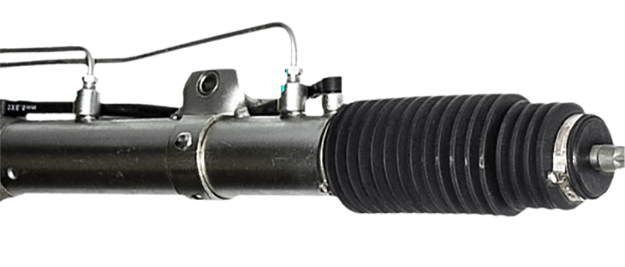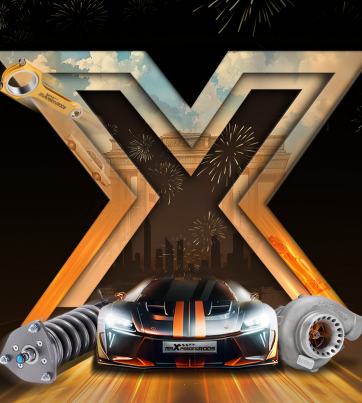Buying a steering rack for your car can sometimes be a daunting and confusing task. At maxpeedingrods.com, it is our mission to make that task as an easy and painless as possible. This Buyer's Guide is designed to answer any questions you may have during your search for the right steering rack for your car, and how to buy steering rack on our website.
What is a steering rack?
Also known as the rack and pinion, the steering rack is the assembly in a vehicle which turns the vehicle's wheels from side to side in response to when the driver turns the steering wheel. In fewer words, the steering rack is what helps you steer when you drive. In heavier vehicle applications, this rack and pinion is often replaced by a steering gearbox. There are several different types of steering rack options available, power steering, manual steering, and now electric steering.
• Manual Steering RackManual steering racks do not have power-assist, so steering is more laborious for the driver when making tight turns. Oftentimes, car enthusiasts will opt for manual steering for track cars, as the application is lightweight and the response is ideal for racing. From the factory, stock manual steering racks are more common in older vehicles. Since most of the manual steering racks on the market are for older applications, we will most likely carry only rebuilt options. We also sometimes carry power-to-manual conversion kits (more information can be found about our kits below).
• Power Steering RackFor a regular commuter car, the optimal form of steering is power steering. Power steering racks will have an extra component, the power steering pump, that will supply high-pressure fluid to rack, providing hydraulic power assist. This makes steering significantly easier for the driver.
•Electric Steering RackElectric power steering (EPS) racks are like power steering racks, except it is powered electronically. The hydraulic assist that you would normally get from the steering pump is now replaced with a computer-controlled electric motor. This is the newest system that automakers are incorporating in their models, since eliminating the pump will increase gas mileage by about 1 mpg.
What are the functions of steering racks?
Steering racks is essentially an enclosed metal casing with rack and pinion gears inside of it. As a
primary component of the car steering system, it helps to:
•Convert rotational motion of our steering wheel into lateral (left and right) motion on our car wheels.
•Makes steering easier through gear reduction.
How to buy steering racks?
You can find your steering racks by entering your vehicle's year, make and model, If for any reason you cannot, you can find it by its Original Equipment Manufacturer (OEM) number. The OEM part number can be found directly on the part itself, usually stamped on a metal tag. You can also call a dealership with your Vehicle Identification Number (VIN), and they have the ability to look up and provide you with the OEM part number. You can contact one of our car specialists through our website for further assistance in purchasing your steering racks parts.
Why buy steering racks at MaXpeedingRods?
MaXpeedingRods has been engaged in the research of overseas racing products and culture for decades. If
you are looking for steering racks, you have landed at the right place. On the basis of your vehicle
make and model, you can choose from a plethora of automotive maintenance and accessories. MaXpeedingRods
offers a seamless online shopping experience and the streamlined e-commerce interface makes it easy for
you to find just the steering racks you want.
MaXpeedingRods offers a variety of steering racks with high quality.
• Power Steering Rack Pinion & Tie Rod Ends
• Oem Fit and Design
• Tested to Meet or Exceed OEM Quality Standard
• Perfect Quality / 100% strict QC

When is it time to replace your steering rack?
When the steering rack goes bad it needs to be replaced quickly for your own safety. But first, you should be sure that the steering rack is at fault. Look for these five telltale signs before you take your vehicle in for repairs.
1. Car WanderingIf your car is wandering on the road, both at low speeds and high speeds, it's a sign that the steering rack has gone bad. You'll need to constantly correct the direction and holding the wheel in place will take much more work than usual. Sometimes this problem can be attributed to your wheels being out of alignment, but with a bad steering rack, the tires will show unusual wear specifically on the inside or outside of the tire, rather than all over like an alignment issue will cause.
2. Numb SpotWith a bad steering rack there tends to be a so-called “numb spot” in the center of the steering mechanism. Between about 11 o'clock and 1 o'clock there might be little response, a certain indication that there are steering rack problems.
3. Wheel ShakingIf the steering wheel shakes when moving at higher speeds, coupled with too much play in the wheel, the steering rack has probably gone bad and needs to be replaced. Apart from anything else, the lack of control with a wheel shaking can prove to be dangerous, especially on freeways when you have a regular commute.
4. Power Steering Fluid LeakIf your power steering fluid levels keep dropping, even after you've topped it off, then it's time to have the steering rack looked at and possibly replaced. Check fluid levels regularly and look for other signs in conjunction with this one so you can be sure this is a steering rack issue and not just a fluid leak.
5. NoisesSometimes when this part is going bad, or more specifically if it's loose, you can hear a thudding, clunking, or frequently knocking as you drive. Even if your problem doesn't turn out to be a steering rack malfunction, noises like these should always be investigated by a professional quickly. Don't just look for one of these symptoms, as some of these things can be caused by more than one problem with your vehicle. If you notice any of these signs, look specifically for some of the others so you can know for sure that your steering rack is the cause.

How to install steering racks in a car?
You turn the steering wheel to go down the street, and the wheel is extremely stiff. You open the hood
and look for an obvious problem. The power steering belt is still there, and the power steering is full.
The power steering fluid is black as night, but it is full. The belt looks a little worn, and it's past
the four-year power steering belt replacement interval. So you put a new one on. A few days later it
happens again. This is what's known in the trade as "morning sickness." It doesn't get better, only
worse.
The cause is normal wear and tear on the internal parts of the power steering rack, or "the rack" as we
call it. The black power steering fluid is black because of metal worn from the inside of the rack and
had become like sandpaper, eating away at the rack. So you will need to replace the power steering rack
and flush the power steering system to get rid of all the old fluid.
• Jack
• Jack stands
• Wrenches
• Ratchet and socket set with extensions
• Screwdrivers
• Pliers or vise grips
• Hammer
• Wire brush
• Tie rod separator or ball joint fork
• Engine support fixture (If required)
• Power steering filter
• Power steering fluid
• Automatic transmission fluid
• New power steering rack
• Latex gloves (Optional)
Step1: Put the wheels in a straight-ahead position. The steering wheel should be in the center position.
Remove the key from the ignition and make sure the steering wheel is locked. You do not want the
steering wheel to turn while removing the rack. Doing so will make it possible for the spiral cable in
the steering wheel to unwind and become useless.
Step2: Crack loose all the wheel lug nuts
Step3: Raise and support the vehicle with approved jack stands.
Step4: Remove both front wheels.
Step5: Remove the Steering Shaft Coupler Outer Seal and unbolt the upper pinch bolt on the Steering
Shaft Coupler assembly.
Step6: Detach the outer tie rod ends. You may need to use a special tie rod end puller to get them off.
You can rent one at the local rental store. Most times a sharp rap with a BFH on the end of the tie
rod mount will shock it loose. Do not hit the tie rod end itself.
Step7: Remove any parts required to gain access to the rack mounting bolts, lines and steering
coupling.
Step8: Depending on accessibility, at this point, you can remove the power steering rack mounting bolts,
or crack the power steering high pressure and return lines.
Step9: Depending on accessibility, at this point, you can remove the power steering rack mounting bolts,
or crack the power steering high pressure and return lines. It may be easier to get a wrench to swing
on a power steering line fitting once you've unbolted the rack and moved it a bit. Also,
reattaching the lines may be easier before the new rack is bolted in place.
Step10: Place a drain pan under the vehicle and remove the hydraulic power steering pressure hose and
power
steering return hose from the power steering rack.
Step11: Now comes the fun part, twist and turn and jiggle it out through one of the wheel well openings.
Make sure the kids are in the house because certain words will be necessary to coax the rack out
and they are not words little ears should hear.
Step12: If the new rack has new tie rod ends, measure the overall length of the old rack and tie rod
assembly.
Set the overall length of the new assembly to this same dimension by twisting the tie rod ends on their
threads.
Keep the rack centered and split the overlap difference between the left and right rod ends as you do
this,
or the steering wheel will be off-center when you're done.
Step13: If you are reusing the old tie rod ends, crack the lock nuts loose. Count how many full turns
it takes to remove the tie rod ends. Center the new rack and install tie rod ends the same number
of turns on the new rack. Again, check the overall length and split the difference.
Step14: Install the new rack using the same words you used to get it out.
Step15 Reconnect the power steering lines, using new "O" rings, if required. Usually, the high-pressure
line uses a slightly larger "O" ring so be careful not to mix them up.
Step16: Reconnect the Steering Shaft Coupler assembly and bolt the rack back into place.
Step17: Reattach the tie rod ends to the steering knuckles. Use new cotter pins for the castellated
nuts;
never reuse the old cotter pins.
Step18: Put the wheels back on and torque the lug nuts to specifications.
Step19: Remove the return line from the power steering pump and place the end into a bucket.
Step20: Fill the power steering pump and start the engine until clean fluid
comes out of the return hose. You may be able to install an inline filter in
the return line to protect the new rack. I have known guys who have used fuel filters for this
purpose.
Step21: Have the front end aligned to reset the toe-in adjustment to specification or the vehicle will
handle poorly and wear out the tire quickly.







